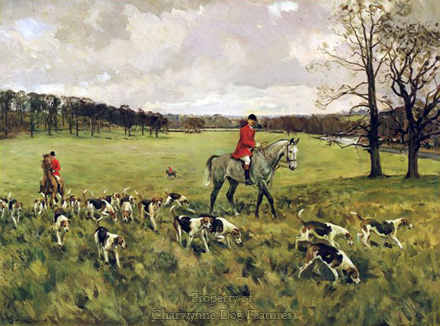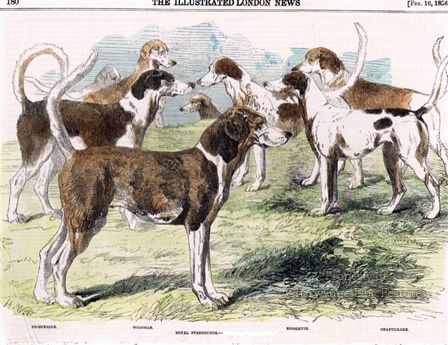292 looking at hounds
LOOKING AT HOUNDS
by David Hancock
 "A perfect foxhound is like a great picture -- its wondrous beauty grows upon you by degrees, and the more you look the more you admire..."
"A perfect foxhound is like a great picture -- its wondrous beauty grows upon you by degrees, and the more you look the more you admire..."
from 'Hunting' by Otho Paget, 1900.
Looking at hounds will always be a source of joy to me, the condition of the hounds alone giving so much pleasure. A houndshow, especially one as well-conducted as the annual Honiton event, is for me a celebration of all the pleasures provided by these canine athletes. The sheer style and restrained pageantry of judging at a houndshow adds to this celebration, a welcome contrast to the urban atmosphere of most Kennel Club-licensed dog shows.
Thirty years ago I was standing at the ringside of a KC championship dog show when I overheard the following conversation; younger man: "Why does the judge need to put his hands on the dogs?" Older man: "Because you don't become an architect by staring at walls!" I was reminded of this snatch of converation when attending the 1999 houndshow at Honiton. The judges were immaculately attired; the hounds beautifully presented; their handlers colourful and impressive; the sun shone, all was right with the world; but was it?
This splendid show, with its dazzling array of hounds: beagles, harriers, foxhounds, staghounds and minkhounds, is always rewarding to visit but this time I felt disappointed. First of all, only the minkhound judge examined the mouths of exhibits; does dentition, 'bite' and jaw construction not matter in animals designed to hunt? Secondly, the hounds were never touched by the judges, to verify muscle tone, bone and the construction of key joints. Thirdly, the hounds could only be animated in the ring by being urged to chase a constant shower of small biscuits. To me this totally degrades canine athletes bred to near perfection and shown in superb condition. Here were magnificent hounds from distinguished packs being treated like village curs. Could they really not show off their movement without such demeaning public bribery?
After several months of watching all too many overweight undermuscled dogs parading, sometimes waddling, around the rings at KC conformation shows, it was a delight to see the rippling muscles, effortless movement and sheer athleticism of these well-bred functional animals. These were surely the best of the best, this was their day, rosettes awaited. But then came a further disappointment as I studied one or two hounds quite closely and was allowed to run my hands over them. Behind the muscular suppleness, graceful outlines and noble bearing, were some of the long-acknowledged anatomical scenthound faults: Fleshy feet, toeing-in, overboned pasterns and ramrod straight forelegs when viewed from the side. This was disappointing, because although none of these flaws were present to an alarming degree, these were the very best hounds of their packs, carefully selected representatives.
I suppose it could be argued that if hounds can hunt successfully over a long day in difficult country, then that is the best possible test for them. But a houndshow is a competition to find the best-made hounds, often with breeding programmes in mind. If judges are not going to bother to look at mouths, examine the feet or feel the shoulders and loins of the exhibits, faults can so easily be overlooked. If hounds can be entered, with the intention of their not only representing their pack but also striving for the honours, whilst carrying noticeable physical flaws, then, behind all the admirable glamour of such a prestigeous show, is there real credibilty?
That may sound over-critical and as though arguing a case for fault-judging, with the latter of course something to be discouraged. But I don't want our precious hounds to be judged on the bloom of their coats, their showiness when 'stacked' or their flashy markings but on their soundness. In any sporting dog, and especially in a hound used to hunt live quarry, feet and legs, shoulders and loins, the position of the elbow and jaw construction are vitally important. If the hounds taken to a houndshow to be judged on the flags by the experts of the day have worrying faults, what are the hounds like which are left in kennels?
In the second half of the 19th century, the foxhound fraternity lost its collective head and actually favoured massive leg bone, over-knuckled feet, bunched toes and woefully pin-toed fronts. The redoubtable 'Ikey' Bell and his followers fought hard against such folly and the penalty to a hound of being over-timbered or unsound afoot was eventually conceded. Quite why any lover of hounds would want them to resemble carthorses has never been satisfactorily explained. What is frightening about what Daphne Moore has called the 'longhorn' era is that so many highly-experienced MFHs and huntsmen went along with the foolishness of the day.
That is why it is worth the risk of the accusation of being hypercritical and of suggesting judging on faults. At a time when there are serious external threats to our native hounds we can do without internal ones. When I judge working terriers, I assess their physical soundness, the ability of their anatomy to allow them to perform in the field. When I judge working tests for gundogs, I assess them on their working skills as displayed at the time. When I judge American Bulldogs, I look for the construction of a 'catch-dog' or 'holding dog', as once needed by primitive hynters to 'grip' their quarry after the scenthounds had hunted and 'bayed' it. Sporting dogs, whatever their cosmetic appeal, have to function.
Major Maurice Barclay, in 'Hounds and Dogs' (Lonsdale Library), 1932, makes a point for me when he states: "...it is with the working capabilities of a foxhound in view that judges at Hound Shows look for certain points. These points are not just for show purposes to please the eye and fashion only, as so many unthinking sportsmen seem to imagine." I would like to see houndshow judges, and 'not just for show purposes', examine mouths. Jardine, in his well-known 'Hounds of the World', 1937, wrote that: "In judging hounds, little or no attention is paid, as a rule, to their heads..." Whatever the precedent, it cannot be good sense, heads, especially jaws, really do matter.
Jardine also wrote: "...that exaggerated straightness which causes a hound to turn his toes right in, is a mistake." At Honiton there were several hounds with pin-toed fronts. There were several hounds there which were far too straight in the foreleg when viewed from the side. In his 'Foxes, Foxhounds and
Foxhunting' of sixty years ago, Richard Clapham noted that: "It will be easily understood that the shorter and straighter the pastern, the more jar will there be, and the quicker will it be carried to the knee, and so upwards. Also, the heavier the bone, the greater the concussion..." There were several hounds at this show which were too straight in the pastern in profile and overboned at the knee.
In her informative 'Foxhounds' of 1981, Daphne Moore wrote: "Good clean flat bone, similar to that of a greyhound, is the type required, not the rounded vulgar variety..." Why would anyone want a hound with thick ankles? When the esteemed Beckford wrote in his 'Thoughts on Hunting' of 1930 on the foxhound "Let his legs be straight as arrows...", he meant when seen from the front, not the side. Most of the hounds in the ring at Honiton in 1999 were excellent. Some however displayed too much weight on the forehand, standing on the outside of each foot, pin-toed fronts, out at elbow, knuckling over at the knee and bunched-up toes. Some may have had defective mouths but this would have gone undiscovered.
For any hound carrying such disabilities to be even taken to a houndshow is disturbing. For the judges to overlook such basic flaws is even more disturbing. Judges at such events have to ask themselves "Could the hound in front of me succeed in the hunting field?" The late Sir Newton Rycroft once wrote in 'Hounds' magazine: "...if a truly great breeder wins prizes at a big hound show in front of two good judges, all credit to him, he will never let it affect his breeding plans..." Wise words; houndshows have a role but it needs a concentration not on canine beauty but on structural soundness
In his valuable book 'Hounds and Hunting' of 1937, Joseph B Thomas, a respected American MFH, wrote: "The British are the greatest breeders of livestock the world has ever seen or probably will see. They breed their mares to the winner of the Derby; they breed their greyhound bitches to the Winner of the Waterloo Cup; and yet they often breed their foxhound bitches to the Winner of the Peterborough Show, which winner is judged ...without regard to what this same animal can do in accounting for foxes, or whether he has cry or nose." Houndshow judges can hardly be expected to judge cry or nose, but they are perfectly capable of spotting anatomical flaws which handicap a hunting dog and should be penalised not be rewarded. The immaculate turn-out of judges and hounds is very much part of the cosmetic appeal of such a show, but a rosette won after a wholly visual examination of noble hounds, mostly whilst there is an unseemly and rather degrading scrabbling for bits of biscuit is not going to earn real respect. We must be careful unless we pass on these precious hounds to future generations with inbred faults; judges at houndshows can shape the future by settling on designs, rather like architects -- who didn't become qualified by only 'staring at walls'!